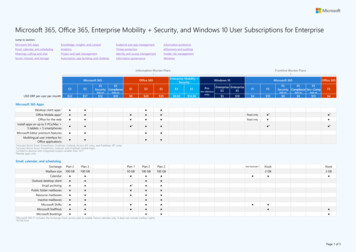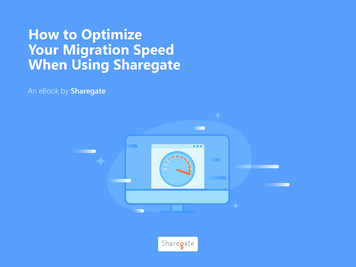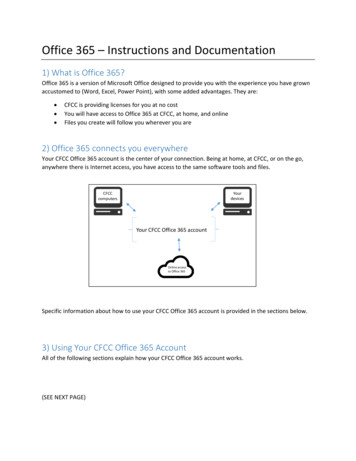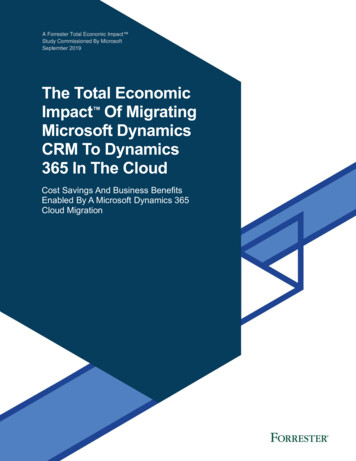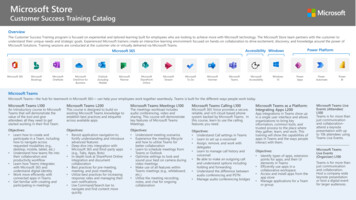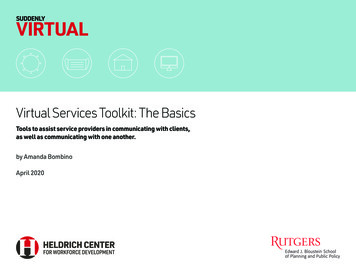
Transcription
Microsoft 365Adoption GuideAdoption Best PracticesDate 01-22-19 Copyright Microsoft Corporation. All rights reserved.
Why does adoption matter?The business landscape is changing. Employees seek purpose and satisfaction. Employers aim to harness worker ingenuity. And adiverse, multi-generational workforce can now work anytime, anywhere. Success depends on your ability to collaborate and driveproductivity within teams spread across the globe. We created Microsoft 365 to meet these evolving business needs. It is a suiteof powerful tools that optimize productivity in today’s corporate landscape.We understand that adopting new technology involves change, and change can be daunting. Even for the most innovative,cutting-edge organizations. That’s why we created the Microsoft 365 Adoption Guide.We’ve compiled an easy-to-follow how-to guide that walks you and your team, step-by-step, through the best way to roll outMicrosoft 365 to your organization. The insights we share come from our most successful customers, who have maximized thepower of their investment, adopting multiple, integrated technologies that now form Microsoft 365. Throughout this guide youwill find links to additional tools and resources as well as the Adoption Planning Workbook where you can build your customapproach to adoption.Remember, you are not in this alone. There are many organizations who are currently launching Microsoft 365 technologies andyou can connect with them in the Driving Adoption Community.The way we work is becoming more connected, let’s connect the way we work.
The successful adoption of new technology requiresbehavior change. And change can be hard.It takes more than learning a new app. It's afundamentally different way of working.This change is about people.And we're here to help.
We know from experience.o Change doesn't happen automatically. Most employeesdon't want to use new technology rolled out by theirorganization.1o CEOs matter. When the CEO was engaged, thetransformation project was more successful.2o Setting targets is key. A well-defined set of financial andoperational targets is a key component to successfultransformation.3o Learn from each other. Learning from co-workers is oneof the most effective ways to adopt new technology.41)2)3)4)Creating organizational transformations, July 2008, McKinsey Quarterly, www.mckinsey.comSharePoint End-User Study, Apr 2013, Microsoft CorporationMicrosoft 365 Usage Research, May 2016, Microsoft CorporationCIO Executive Board Business Productivity Database
80% of end users admit tousing their communication toolof choice 11“Whatis Shadow IT?”, versity/what-is-shadow-it/ (accessed March 2017)
Our successful customers navigate adoption by.1Defining a vision. Companies were most successful when they had a clearlydefined vision and knew how the new technology would be used.2Getting leadership support. Successful projects obtained proactivesupport from senior leadership to encourage new technology use.3Training end-users. Organizations used multiple training formats toengage with employees across business units.4Raising awareness. Top performers used email, employee portals,posters, teaser videos, and newsletters.*Results of a Microsoft research study survey
Our Adoption Framework guides you through theprocessWe have created an easy-to-follow framework to guide you through the adoption process. Each phase is broken into simple stepsthat guide you to the best practices, resources, and tools you need to build and deploy a customized adoption approach.ENVISIONDRIVE VALUEONBOARDIdentify and prioritize scenarios while learningWork with your key stakeholders to build andFull-scale deployment and business successabout available resources as you plan for rollout.launch your adoption plan. Prepare yourdepend on usage and satisfaction. This requiresThis stage is critical to your journey as you’reenvironment and test your adoption approachplanning through the Envision and Onboard phasessetting business goals to measure success.with Early Adopters. Use feedback to makeplus ongoing operational excellence.adjustments before scaling to the business.oooAssemble Your TeamDefine Business StrategyDetermine ReadinessooooPrepare Your EnvironmentBuild Your Adoption PlanLaunch to Early AdoptersAdjust Your PlanoooMonitor End User AdoptionMeasure and Report UsageEncourage Ongoing Engagement
Phase One: ENVISIONENVISIONIdentify and prioritize scenarios while learningabout available resources as you plan for rollout.This stage is critical to your journey as you’resetting business goals to measure success.oooAssemble Your TeamDefine Business StrategyDetermine Readiness
Assemble Your TeamWho should be involvedin your adoption effort?Transforming to this new way of working requires buy-in andsupport from across the business. We have identified four keygroups who will bridge technology and business outcomes thatmatter to your organizationEach group has a specific role in implementation and should beengaged early and often. The next few pages will outline thespecific role these team members will play.Mott MacDonald developed a network oftechnology champions by engaging theemployees who are most interested andenthusiastic about the new capabilities. Thecompany made sure the champions werewell trained and sent them out into the businessto coach and communicate with colleagues.1) Executive Sponsors2) Success Owner3) Early Adopters4) Champions
Assemble Your TeamHow can Executive Sponsors drive project success?Executive Sponsors should:o Help the project team identify and prioritize theirtop business needs.o Play a role in communicating the vision to leadersacross the organization.o Actively participate in and use the Microsoft 365capabilities to help drive and reinforce adoption.o Promote the adoption process. Studies show thatEnsure they understand the ABCs:*ABCActive and visible participationBuilding a coalition with their executive peersCommunicating directly with employees87% of successful transformation projects hadvisible engagement by Executive Sponsors.* Prosci . All rights reserved.
Assemble Your TeamWho are Success Ownersand why are they important?Success Owners ensure business goals are realized byhelping people use and get value from the new Microsoftservice.Success Owners should:o Identify and engage the right stakeholders.o Translate the organization’s set business goals intoMicrosoft 365 scenarios.o Create an adoption plan to drive usage and realizevalue from Microsoft 365.o Ensure communications and training are successfullyimplemented.
Assemble Your TeamWho are Early Adopters?Selecting the right participants for the Early Adopter Program is keyto gain valuable insights and inform the organization-wide launch.The list below describes the types of employee to include in yourprogram:oUsers from different lines of business and departments, preferablythose that work together on a project or business process.oLikely Champions or leaders who will become advocates during thebroad launch to the entire organization.oUsers who typically struggle with technology. It’s important tounderstand and address their needs during launch.oIT and help desk team members who will support users duringlaunch.oImportant: Leave out the CEO and upper management. While it canbe tempting to ask for the CEO’s involvement, keeping them out ofthe Early Adopter Program provides an opportunity to smooth outany issues before they are exposed during the rollout.
Assemble Your TeamWho are Champions?Champions evangelize and help train their teams on the newways of working. They build awareness, understanding, andengagement throughout the community.Champions will:Championswillgroundswellhelp to:o Create theof enthusiasm that grows adoption.We connect with an adoption Champion in eachbusiness unit, who sends out weekly emails onOffice 365. Each Office 365 tool has core benefits andby taking users on a smooth journey through them,we are able to unlock the value in each one.Nick LamshedChange Consultant, QantasoBuild a circle of influence among their teams.oBring the new ways of working to life across teams.oIdentify business challenges and possible solutions.oProvide feedback to the project team and sponsors.oReduce strain on core project team through active, ongoingengagement.
Assemble Your TeamOther team members to include in adoption effortsMany people throughout your organization will have important responsibilities during the launch of a newtechnology. The chart below provides a summary of those roles. We have created a template so you can identify anddocument your team in the Adoption Planning Workbook.RoleResponsibilitiesDepartmentExecutive SponsorCommunicate high-level vision and values of Microsoft 365 to the companyExecutive LeadershipSuccess OwnerEnsure the business goals are realized from your Microsoft 365 rolloutAny departmentProgram ManagerOversee the entire Microsoft 365 launch execution and rollout processITChampionsHelp evangelize Microsoft 365 and manage objection handlingMultiple departmentsTraining LeadManage and communicate training content about Microsoft 365IT or otherDepartment Leads (Stakeholders)Identify how specific departments will use Microsoft 365and encourage engagementAny department (management)IT SpecialistsOversee all technical aspects of the rollout, including integrationsITCommunication LeadOversee company-wide communications about Microsoft 365Corp Communications, IT or otherNote: Though we recommend having each of these roles fulfilled throughout your rollout, you may find that you don’t require them all to get started with youridentified solutions. Visit the Adoption Team Member Role Details for complete descriptions.
Define Business StrategyDefine your businessstrategyPartner with your core team to refine your objectives.Identify Consider these questions to drive the conversation:o What are some of the organization’s challenges or painpoints related to communication and collaboration?o What are the areas in which your organization wouldlike to improve?the important business objectives and challengesand start to recognize areas of opportunity toimprove work processes.o What are the organization’s strategic initiatives orHost a workshop o What methods of communication and collaboration areto delve deeper into current challenges,strategies and goals. Include departmentleads, lines of business, IT and otherstakeholders who can help brainstorm howMicrosoft 365 can be used in yourorganization.current transformation projects that Microsoft 365 cansupport?typically better received by your organization thanothers?o What is the process for drafting, distributing, andsharing information?
Define Business StrategyIdentify your ScenariosWhat is a Scenario?Explore what’s possible.Scenarios cover the ways your people will use Microsoft 365 toaddress business challenges and achieve organizational, cultural,tangible or individual adoption outcomes.The Microsoft 365 Productivity Library is acollection of recommended use cases to showcaseideas on how to use the products to your bestadvantage in a way that’s relevant to you.Why are Scenarios important?The idea cards speak to everyday challenges youcan solve with Microsoft 365 across industries androles and includes short training videos.o They allow teams to understand how Microsoft 365 can help themachieve more.o They act as input and validation of Microsoft 365 awarenessmessaging.o They support awareness and readiness activities by puttingproducts in context; people will know when and how to use them.You can search the cards by Industry, Role orProduct, or any keywords fitting your needs.Get started:aka.ms/productivitylibrary
Define Business StrategyCreate scenarios for multiple teams and departmentsYou can use the worksheet below to document business scenarios for specific departments and thencapture your scenarios in the Adoption Planning Workbook.As someone in (Team)As someone inSales ManagementI want to Using (Description ofwhat I want to do)(Specific applicationof the technology)I want toUsinghave a single version of thesales proposal that everyonehas access to rather thanmanaging multiple versions inemaila SharePoint site to centrallystore and share a single versionof a sales proposal that my teamcan edit together using coauthoring in Word andPowerPointI’ll know this issuccessful when (Solutions successmeasure)I’ll know this is successfulwhenmy sales team creates proposalsmore easily, giving them moretime to close deals
Define Business StrategyCollaborate with colleagues ina chat-centered workspacePrioritize yourbusiness scenariosOnce scenarios have been defined for theorganization and its departments, it is importantto prioritize, so you know where to focus first.Gauging impact and difficulty will help youunderstand which scenarios will provide themost impact the fastest and which require moreplanning.Use this template to prioritize your scenarios inthe Adoption Planning Workbook.Deploy data classification andprotection with AzureInformation ProtectionImpactGauge impact and difficultyImplement secure single signon with Azure Active DirectoryReplace traditional phonesystem with Cloud PBXEmpower and engage employeesthrough a social networkConduct training foremployees across the globeSupport new employeesin onboarding fasterEnable employees to worksmarter, from anywhere, withhosted emailDifficulty
Define Business StrategyDefine your “Minimum Viable Experience” for your userbase. These are the must-have capabilities your servicesneed to deliver. Doing this early will allow you to controlthe scope of your pilot and deployment phases.o Scope change to empower, not disrupt business users.o One large, phased transition is often better thanmultiple small ones.o Each type of service strategy requires all thecomponents of deployment and adoption planning.
Define Business StrategyDefine your success criteriao Identify key performance indicators (KPIs) thatshould improve based on adopting various businessscenarios.o Establish KPI benchmarks and users’ Microsoft 365knowledge.o Choose criteria to help you show leadership the impactMicrosoft 365 is having on the organization.o After rollout, use the end user surveys to measuresatisfaction and progress against yourbenchmark. http://aka.ms/usersurveysView sample KPIs in the Adoption Planning Workbook
Define Business StrategyUse these examples to choose your KPIsChoose criteria to demonstrate the impact of your Microsoft 365 implementation against each success measure. We have providedideas below and scorecard templates in the Adoption Planning Workbook for you to effectively track and report success.Success MeasureReduced operating costsIncreased adoption correlates to reduced thirdparty conferencing usage, travel time and resourceallocationIncreased productivityIncreased adoption correlates to fastercommunication and decision making, shorter timeto complete tasksMethodQuantitativeMicrosoft 365 reportingFinance/accounting reportsTravel and phone expense reportsQuantitativeProcess efficiency gainsExample GoalComparison of pre and post Microsoft 365 reportswill show cost savings. Post rollout usage of thirdparty phone conferencing should show decreasingusage of 10% per monthTime to complete customer orders drop by15% within 6 monthsQualitativeEnd user surveysYammer or Teams feedbackImproved collaborationQualitativeIncreased usage of Yammer or TeamsImproved employee engagementQualitativeEmployee engagement improves by 15% within 6months of rolling out Yammer or TeamsIncreased cross-team and cross-locationcommunicationsEmployees are fully absorbed by and enthusiasticabout their work and are more motivated to helpthe organization achieve its goalsEnd user surveysEmployee surveys
Determine ReadinessDetermine yourorganization's readinessWhat is Readiness?Willingness and preparedness of your users and yourorganization to move to Microsoft 365o Every organization approaches change differently,depending on region, work style, professional profile, andother elements of the organization.o Determine how receptive (or not) your users are likely to be tochanging the way they work and adopting new technology.o You will need to create a rollout plan that reflects the readinessof your organization.Resistance is normal. Anticipate and plan ahead!Readiness factorso There are key factors that will help you understandhow prepared your organization is for the transitionto Microsoft 365o Clear vision for the company shifto Clear vision for the individual shifto Amount of overall change requiredo Executive alignmentDifferent groups within your organization will havedifferent levels of readiness and change appetite.Use the Adoption Planning Workbook to assess yourorganization.
Phase Two: ONBOARDONBOARDWork with your key stakeholders to build and launchyour adoption plan. Prepare your environment and testyour adoption approach with Early Adopters. Usefeedback to make adjustments before scaling to thebusiness.ooooPrepare Your EnvironmentBuild Your Adoption PlanLaunch to Early AdoptersAdjust Your Plan
Prepare Your EnvironmentTechnical Readiness ChecklistPrepare your technicalenvironmentTechnical Readiness is key to ensuring yourorganization is ready for launch. Usethis checklist to identify items that need tobe completed before go-live.Need more help? Review the TechnicalReadiness and Governance Guide andcomplete your own Checklist in the Adoption Planning Workbook. Complete legal & security review Review service capabilities with legal & security teams Decide guest access and provisioning policies Whitelist Microsoft 365 URL's & IP addresses Implement enterprise policies and Microsoft 365 groupgovernance policies Assign report reader roles Complete network assessment (for Voice & Video services) Plan guest access bandwidth Review minimum requirements spec, including mobiledevices strategy Review Microsoft 365 Admin reporting Assign report reader role as needed Prepare help desk
Build Your Adoption PlanDrive awareness through enduser engagementCommunicationso Deploy a variety of tacticso Focus on the “What’s in it for me?”o Tailor plan to company and cultureo Send out communicationsEngagement eventso Engage Executive Sponsors to kick off launcho Staff events with IT and Championso Distribute banners and leafletso Place demo booths in cafeteria/foyero Host online events for remote officesWe knew we had to be crystal clear withemployees about how Office 365 would maketheir lives easier and help them do their jobsbetter. So, we branded it as four things: WorkAnywhere, Work Anytime You Like, WorkTogether, and Work on Any Device.Joe KamaraLead Change Manager, NEC Group
Build Your Adoption PlanDelivering ValueReview scenarios and determine the best use cases tobe utilized for the organization-wide launch.Scenarios will help inform the communications planby:Report and build on winsIdentifyandprioritizescenarioso Translating core scenarios into uses that solve real businessproblemso Determining which scenarios make sense for the companyto promote in its Microsoft 365 launchMeasureand share successo Using the resources associated with each scenario toimplement email announcements and training activitiesPlanand execute
Build Your Adoption PlanIncorporate success storiesSuccess stories are often just as valuable as quantitativemeasures when demonstrating Microsoft 365 success.Throughout the rollout, project team members andChampions should identify examples that demonstrate crossfunctional collaboration and teamwork and share them byusing Yammer or Teams.Leverage these examples in your communications togenerate excitement and demonstrate the impact ofMicrosoft 365.What makes a good success story?o Time. The story should begin with a timemarker so the audience knows when ithappened.o Characters. The story should feature names, sothe audience knows who was involved.o Events. The story should recount the eventsthat took place.o Visuals. The audience should be able topicture what happened.
Build Your Adoption PlanCreate launch eventsHow to choose your launch evento Consider your goals for using Microsoft 365.The following are some resources, ideas, and tactics to helpcreate an effective Microsoft 365 launch:o Planning Team and Champions wear Microsoft 365 T-shirts,order at https://www.co-store.com/iw (US customers only).o Microsoft 365 banners, posters, and leaflets displayedthroughout the offices.o Demo booths in cafeteria/foyer to showcase the variousMicrosoft 365 tools and features, and to provide hands-onexperience.How can your launch event support your businessobjectives?o Consider your company culture. What types ofactivities will resonate with your leadership andyour employees?o Consider your time and resources. Can you mixand match activities to plan something that suitsyour needs and fits into your schedule?o Consider existing company events. Is there anupcoming company event near the roll-out ofMicrosoft 365 that could incorporate your launch?
Build Your Adoption PlanDevelop your communication strategyDevelop a communications strategy that will generate awareness and excitementbefore the launch and share usage success after launch. Consider the following bestpractices when building your approach:o Ensure staff are considered when putting together the messaging to help them identify, “What’s in it for me?”o Pick a mix of activities including email, posters and physical events, and plot them along the project timeline.o Schedule events where people can experience the products and ask questions.o Tailor activities for driving awareness to company and culture.o Having a leader send out a communication announcing Microsoft 365, hosting a launch event, or sharing thebenefits during an all-hands meeting will go a long way in validating its importance and getting everyone onboard with using the new technology.Complete the Communications Assessment and use planning templates in the Adoption Planning Workbook.
Build Your Adoption PlanAccess helpfulcommunicationresourcesExplore free online templates and tools forengagement content that you can include in yourcommunications.Check in with the Driving Adoption TechCommunity to connect with adoption experts andlearn how they have communicated the Microsoft365 launch to their organizations.Posters, booklet and printCountdown and Announcement .ms/AwarenessTemplatesAwareness KitsWindows 10 Business Introduction KitAwareness Kitshttps://aka.ms/win10businesskitUse the Adoption Planning Workbook toorganize and track content.
Build Your Adoption PlanBuild your training strategyFocus on the whyMake sure employees know why the change is happening, what’s init for them, and why they’re being asked to change.Use real work scenariosUse tasks or business processes that are familiar to your audience todraw them into learning how to use the technology.Use multiple formatsTraining end users should take on multiple forms to accommodatedifferent learning styles, geographical barriers and resourceconstraints.ReinforceMake the training stick with reinforcement options like on-demandtraining, lunch and learn sessions, and new employee trainingoptions.To help with change management and adoption, wecreated corporate Office 365 training materials with aconsistent approach to using the services thatdiscouraged customization and kept complexity to aminimum. As a design principle, we use the defaultsettings in Office 365 for at least six months.Anders MunckEnterprise Architect, Carlsberg
Build Your Adoption PlanConsider training best practicesWhen you are putting together your training program, take into consideration:1234The current productivity tools you are runningIf you are currently running a productivity system, you may need to spend an increasedeffort in the training stage, as it will require a change in behavior.The technology literacy of the staffYou need to understand how tech-savvy your staff are when planning your training program.This will help to determine how easily they will pick up new ways to work.The current change programsIt is important to understand what other programs are currently running in the business, sodo not overwhelm or confuse your staff.Training preferences of your staffIt is important to understand the best way to deliver training to your organization, whether itbe in person, through assisted or unassisted online tutorials, or other methods.
Build Your Adoption PlanAlign your training strategy to the launch planDesign your training strategy to scale with your launch. Start with the groups that willchampion Microsoft 365, then prepare IT, before launching to the broader organization. ManagersEarly AdoptersChange ChampionsExecutive SponsorsCore Team Administration coursefor IT resources Formal accreditationIT Preparation Auditorium Training Online/On-DemandTraining Brown Bag sessionsBusiness Groups Lunch & Learn Tips and TricksOngoingEngagementUse the Adoption Planning Workbook to assess the training needs of your organization andbuild your approach to training.
Build Your Adoption PlanMicrosoft 365 Training CenterAccess trainingresourcesAccess free online training resources to helplaunch Microsoft 365.Check in with the Driving Adoption TechCommunity to connect with adoption expertsand learn how they have communicated theMicrosoft 365 launch to their organizations.Product based training to help ready people touse the services and apps effectively.office.com/trainingOffice Quick StartsProductivity TrainingScenario based training to ready people to maximizetheir productivity with Microsoft 365.http://aka.ms/productivitytrainingMicrosoft 365 YouTube ChannelGet up and running quickly with the basic info youneed to be productive right away.Discover how Office 365’s integrated experience canhelp you grow your business.Office 365 Quick Start Guideshttps://www.youtube.com/user/officevideosUse the Adoption Planning Workbook toorganize and track content.
Build Your Adoption PlanBuild a sustainable Champions CommunityChampions help build, grow, and sustain your Microsoft 365 rollout by evangelizing and helpingtheir peers with the new technology.Champions:Get started:Champions GuideGet inspired:http://aka.ms/bestbuyninjas1Should be formally trained to increase theirdepth and breadth of knowledge.2Should be encouraged and empoweredto guide, teach, and train their peers.3Need consistent positive reinforcement that affirmsthe impact of their efforts.4Need a clear plan to execute.
Build Your Adoption PlanIncorporate Champions Community into the launch planAdoptionapproachBusinessscenariosIdentify key stakeholdersIdentify/Prioritize businessscenariosCreate & execute a Success PlanMeasure, share success,and iterateIdentify and launch additional solutionsMicrosoft 365 early adoption program with championsHighlight and share successCommunicationsand trainingIT and socialgovernanceOrganization-wide launch: communications,training, events, success storiesOrganize and develop Champions e Champions CommunitySupervise licensing, security and social governance discussionsReview ofdomainsAssessviability ofthird partiesAssist inreportingSupportmobile appsSupport global launchSample Champions Community Launch Timelines
Launch to Early AdoptersBuild and launch your EarlyAdopter Program strategyWhy is this program important?o Identify pitfalls. Gather initial feedback andAn Early Adopter Program gives your organization earlyinsights that will help you bring Microsoft 365 to life for allusers. Think of it as a dry run, among a representative group,that will help you prepare for full-scale launch.identify potential stumbling blocks to helpshape your final launch plan.o Collect feedback. Get feedback from users onthe identified goals and scenarios for yourMicrosoft 365 implementation.Working with Early Adopters lets you test your ideas andcollect feedback that will help your project team bring that“WOW” factor to your full, organization-wide launch.o Solve problems. Troubleshoot potential issuesFind all the resources you need to organize, plan, and launchyour Early Adopter Program in Microsoft's Early AdopterProgram Guide.o Recruit Champions. Develop a pool of potentialwith a smaller group of users prior to anorganization-wide launch.enthusiasts to recruit from. These individualswill help colleagues adopt Microsoft 365 oncethe full rollout takes place.
Adjust Your PlanUse feedback from Early Adopters to revisit yourcommunications, training, and feedback plans.Adjust your overall approach based on the inputreceived.Consider bringing your Early Adopters into theMicrosoft 365 Champions group so they cancontinue to support their peers through thetransition.
Phase Three: DRIVE VALUEDRIVE VALUEFull-scale deployment and business success dependon usage and satisfaction. This requires planningthrough the Envision and Onboard phases plusongoing operational excellence.oooMonitor End User AdoptionMeasure and Report UsageEncourage Ongoing Engagement
Monitor AdoptionTrack KPIs and end useradoptionIf your company is not meeting its KPIs, consider possible reasons why end usershave not fully adopted the technology.Distribute satisfaction surveys to gather data about your users’ knowledge of andsentiment toward the new Microsoft 365 services. The results will help youdetermine how successful the rollout has been and get you thinking about howto incorporate this feedback into actionable next steps:oCirculate a baseline survey shortly before users receive their accounts anddevices, to gather data about their knowledge of Microsoft 365.oConduct a survey halfway through your launch to gather data aboutusers’
That’s why we created the Microsoft 365 Adoption Guide.-to follow howto guide that walks you and your team, step by step, through the best way to roll out . SharePoint End -User Study, Apr 2013, Microsoft Corporation 3) Microsoft 365 Usage Research, May 2016, Microsoft Corporation . has access

